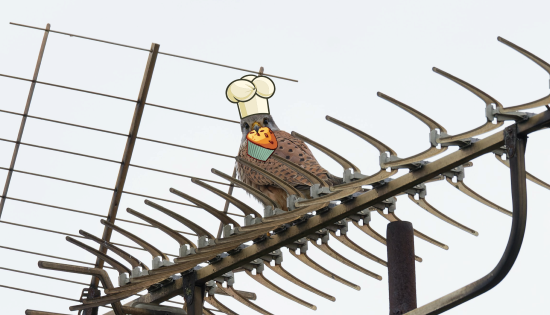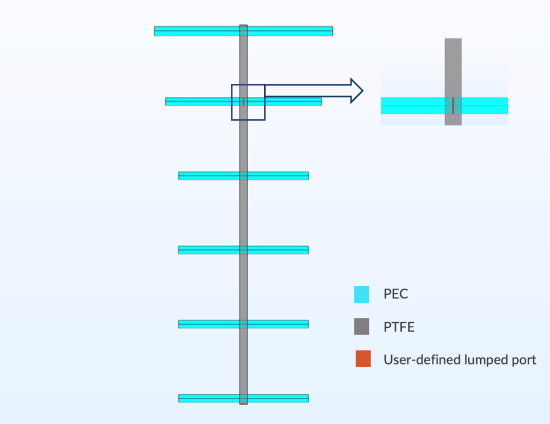For some food lovers, there is nothing like the smell of freshly baked muffins. Whether chocolate, blueberry, or pumpkin, these sweet treats are especially delicious when warm. In a hungry and curious mood, we decided to try heating up muffins with an unconventional device: a Yagi–Uda antenna. Through multiphysics modeling, let’s see if it’s possible to use an antenna in this delicious application — or if we are doomed to eat our treats cold.
Have You Heard of These Unique Heating Methods?
For as long as there has been food, people have been playing around with the best way to heat it. For those still searching for the ideal heating method, look no further than the homemade solar oven and its s’mores-making capabilities. In this fun experiment, people add aluminum foil and plastic wrap to a custom cardboard box and move it into the sunlight. The cardboard box is then able to function as a solar oven, slowly cooking the snacks inside to crispy perfection. Channeling this creative energy, we approached heating our muffins in a completely unconventional way.
Antennas are typically found transmitting television signals, such as within mobile devices or on airplanes. In these applications, the movement of electrical charges in the antenna produces electromagnetic waves that are harmless and have no major heating effect. However, at particular frequencies, antennas are able to generate intermolecular friction in objects and heat them up. If tuned correctly, an antenna should work well as our hypothetical oven replacement.

A kestrel perched on an antenna enjoys a chocolate chip muffin. Who knew these birds had a sweet spot for baked goods? Photo by Regine Tholen on Unsplash. The original work has been modified.
Modeling Microwaves (Just Not the Appliances)
For this fun modeling example, we wanted to avoid an omnidirectional antenna because of its associated 360-degree radiation pattern and comparatively low gain. These attributes make this style of antenna less safe and less effective to use than their directional counterparts. For this reason, we chose to model a Yagi–Uda antenna.
Now, antennas — directional or omnidirectional — bring limitations when it comes to cooking. For instance, antennas only generate heat through radiation. This is a disadvantage compared to the traditional appliances in your kitchen, which can rely on convection and conduction. Despite this, we hoped that our antenna would generate an electric field with enough strength and directional control to overcome this limitation.
Our antenna model, which we built using the COMSOL Multiphysics® software, features a driven element (where power is applied through a feedline), a reflector (situated in the opposite direction of the electromagnetic field), and four directors (which tend to make an antenna more powerful and more directional). We also made use of the RF Module, an add-on product to COMSOL Multiphysics that provides specialized functionality for RF modeling. Users can readily characterize the performance of radiating elements (such as the antenna in our example) in terms of directivity and gain from its radiation pattern with this module.

A Yagi–Uda antenna in the COMSOL Multiphysics® software with 4 directors at the bottom, a driven element near the top, and a reflector at the top. These components are attached to a bar made of polytetrafluoroethylene (PTFE), and each element is considered a perfect electrical conductor (PEC).
For this application of the Yagi–Uda antenna, we should establish our parameters. Following in the footsteps of traditional consumer microwave ovens, we tuned our Yagi–Uda antenna to 2.45 GHz. This creates the intermolecular friction required for heating food. We also decided to have the muffins move through the antenna’s electromagnetic field via a conveyor belt to reduce the risk of overheating them. We were, after all, trying to reheat the muffins, not burn them. For the purposes of this simulation, we modeled two muffins with the following properties:
- Relative permittivity = 65-j20
- Electric conductivity = 0
- Thermal conductivity = 0.55 W/(m*K)
- Heat capacity at constant pressure = 3640 J/(kg*K)
- Density = 1050 kg/m3
In the simulation, we conducted a parametric sweep to account for the motion of the muffins as well as a time-dependent study to see the change in temperature over a span of 12 seconds. Thanks to the heat transfer variables of the time-dependent study, the simulation showed the electromagnetic field that the antenna produces, enabling us to visualize the temperature spread in the muffins.
If we were to bring this simulation to life, we would watch our pair of delicious muffins move along a conveyor belt, underneath the antenna, and to the other side.
With the model set up and solved, we can check on the results and see if our snack has been properly heated.
Signaling an Effective but Unconventional Way of Heating
The results point to a pair of hot muffins. Portions of each muffin reach temperatures above 45°C, and, as expected, the areas closest to the antenna generated the most heat. After exposing the muffins to electromagnetic energy, the average temperature variation of both muffins exceeded 40°C by the end of the allotted time. Both muffins also experienced maximum temperature variations of over 110°C. Of the two, the second muffin reached a higher average and maximum temperature, the latter exceeding 120°C.
These simulated results indicate that Yagi–Uda antennas can be used to heat muffins quickly and significantly. While this makes our simulation a success, there is muffin that these antennas will replace in your kitchen in the short or long term. Instead, you should probably keep your Yagi–Uda antenna atop your roof and your muffins in the oven.

